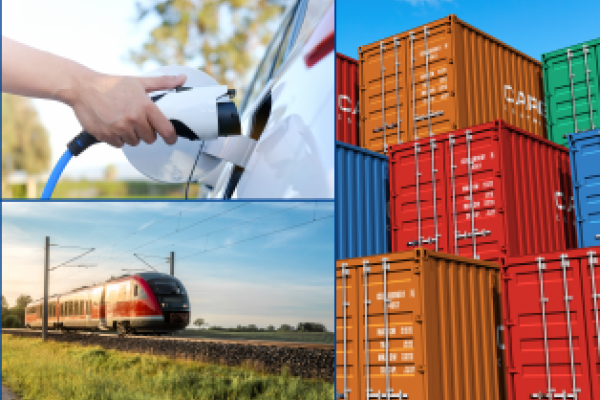Synergies among programmes
All CINEA managed programmes contribute in a complementary manner to fund a green future for Europe, while each programme has its own specific scope and features. Consequently, projects can develop synergies either as a progression from one programme to another (for example from research to deployment and market roll-out), or they can complement each other whilst working in the same thematic area by tackling issues from different perspectives. This has to be done in compliance with the principle of no double funding laid down in Article 191 of the Financial Regulation.
Progression - From research to development
Several Horizon 2020 (H2020) funded projects contributed to the development and testing of an innovative technology which captures carbon dioxide from the air, dissolves it in water and finally turns it into stone. The industrial/academic research programme CarbFix project laid the foundations for this technology, which was subsequently scaled up and tested by the award-winning CarbFix2 project at the Hellisheidi geothermal plant in Iceland. The Carbfix technology will be brought to full commercial scale by the Silverstone project, financed by the Innovation Fund, which will deploy commercial scale CO2 capture and mineral storage of the emissions in the same geothermal power plant in Iceland, enabling Hellisheidi to reach a near-zero carbon footprint.
Intelligent Transport Systems (ITS) solutions which are today deployed in the CEF Transport Arc Atlantique Corridor Phase 32 project on roads in Belgium, France, Ireland, the Netherlands, Spain and the UK have matured in three different H2020 Transport projects: the HIGHTS project, which developed a high precision technology allowing to position vehicles with the accuracy of 25 centimetres, the ARTIC project that resulted in an intelligent car-to-car communication system and the CarNet project that brought to the market a high-speed data transmission antenna to enable better communication between vehicles and infrastructure.
In the challenge to take steelmaking to near zero emissions, the LIFE SMART project in Ghent (Belgium) aims to replace part of the fossil coal fuel by a mix of industrial residuals and non-recyclable plastics with a high carbon content, in the form of pellets. These pellets are then transformed into intermediate coke or powder coal in the coking plant or torrefaction installation tested under the 2020 TORERO project. These are then fed into a blast furnace to turn iron ore into steel. During this process, exhaust gases can be converted to ethanol (a useful molecule for the chemical industry) in the installation created under the H2020 STEELANOL project.
Complementarity - Working side by side in the same thematic/geographical area
Industrial Carbon Management
Three programmes (Horizon Europe, the Innovation Fund and the Connecting Europe Facility) work together to support decarbonisation in the North of France. An innovative process of carbon capture from industrial activities is demonstrated by the 3D project co-funded by Horizon 2020. It combines partners from research and industry and explores validation of replicable technical solutions at a steel industry in the port of Dunkirk.
The K6 project, funded by the Innovation Fund, will transform one of the oldest cement plants in Europe, situated in Hauts de France. The project will deploy a first-of-a-kind industrial-scale combination of an airtight kiln and cryogenic carbon capture technology. The captured CO2, otherwise emitted in the atmosphere, will be stored in a permanent storage site in the North Sea (this part of the technology chain falls outside the Innovation Fund project).
Finally, these two projects will be key in supporting the development of a strategically important CO2 export hub in the port of Dunkirk, which is supported by the CEF Energy programme under the D’Artagnan project. This project develops a CO2 export multimodal open access hub in Dunkirk, and it is a Project of Common Interest (PCI) under the Trans-European Networks for Energy (TEN-E Regulation), potentially expanding this value chain and logistic solution to other emitting industries.
 | Thematic publicationSince 2018, CINEA has built up a portfolio of 101 projects and actions involving EUR 4.4 billion in EU contributions, for 698 beneficiaries, from 42 countries across the Industrial Carbon Management value chains. These are funded by three EU programmes: the Connecting Europe Facility for Energy, the Innovation Fund, and Horizon Europe. |
Waterborne
Projects funded by Horizon Europe and CEF Transport address the need for reducing CO2 emissions and air pollution from waterborne transport by testing and deploying new technological solutions for 100% electrically powered vessels.
E-Ferry is an H2020 innovation project developing and testing an electric ferry with the world’s largest battery, allowing it to travel further than existing electric ferries before needing to be recharged. Zero Emissions Ferries is a CEF Transport project that converted two existing complex roll-on/roll-off passenger ships – originally fuelled by heavy oil – to electric powered operation exclusively using batteries. The required power provision and charging installations in the ports/ferry terminals were also realised as part of the project.
 © European Commission | Thematic publication This Synergy Info Pack highlights how projects from different countries, sectors and funding programmes are all working towards the same goal: making Europe’s waterborne transport sector more sustainable, more efficient and more competitive. |
Other publications
|
| This CORDIS Synergy Info Pack highlights how projects managed by CINEA and coming from different sectors and funding programmes are all working towards the same shared goal: delivering the European Green Deal and the green transition. |
 | Smart, green, efficient: new videos on how the EU drives the clean energy transition Discover a new video series showing how EU-funded projects contribute to meet the EU Green Deal objectives in building renovation, changing consumer behaviour, decarbonising industry, emerging technologies, transport, renewables and smart grids. |



